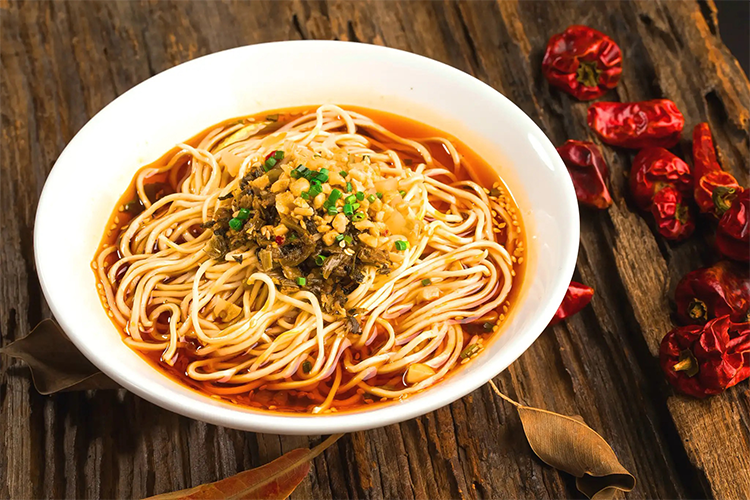Dandan Noodles: Spicy Sichuan Street Classic
1. A Bowl’s World: Discovering the Spicy Soul of Sichuan Dandan Noodles
Imagine walking through the bustling streets of Chengdu, where the air is filled with irresistible aromas. Among them, the rich scent of sesame sauce, chili oil, crispy minced pork, and the numbing tang of Sichuan pepper leads you to a humble street food stall. Here, a vendor skillfully pours flavor into each bowl from a shoulder pole—this is Dandan noodles, a quintessential Sichuan street food that captures the bold, layered essence of Sichuan cuisine.
2. Origins: The Flavor Born from a Shoulder Pole
The name Dandan comes from the shoulder poles once used by street vendors. Legend has it that during the Qing dynasty’s Daoguang era, salt workers around Zigong needed quick, filling meals. Street hawkers carried stoves and pots on one end and bowls, condiments, and utensils on the other, cooking noodles on the spot. This mobile kitchen offered a hot, affordable, intensely flavored bowl perfect for laborers. Over time, the dish spread from Zigong to Chengdu and across the Sichuan Basin, preserving its street-food charm while becoming a nationwide favorite.

3. Cultural Meaning: From Street Snack to Banquet Delicacy
Dandan noodles hold a unique place in Sichuan culinary culture. They function both as a quick snack for locals and as a refined small dish on banquet menus. On the streets, they reflect a practical, lively attitude toward food—fast, bold, and invigorating. In formal settings, a small, precisely seasoned bowl of Dandan noodles often serves to cleanse the palate between rich courses, proving that humble street food can also be elegant.
4. Ingredients and Flavor: A Symphonic Bite
Authentic Dandan noodles achieve harmony through carefully balanced components:
- Noodles: Thin, alkaline-style noodles with a smooth, elastic texture.
- Crispy minced pork: Pan-fried until dry and aromatic; absorbs sauce while adding savory crunch.
- Pickled greens: Sichuan preserved greens (crushed rice sprouts or Chuan Dong Cai) for salty, fermented depth.
- Rich sauces: Sesame paste and soy sauce provide creamy, savory balance.
- Numbing-spicy duo: Chili oil for heat and color, Sichuan pepper for signature tingling “ma.”
Additional toppings include roasted crushed peanuts, scallions, minced garlic, and sometimes blanched pea shoots. When mixed, the first taste is sesame’s creaminess, followed by crispy pork, pickled greens, and the rising heat and numbing sensation, all rounded by peanuts and scallions—a layered, satisfying flavor journey.

5. How It’s Made and How to Eat It
Making Dandan noodles requires skill. Traditionally, a seasoned bowl is prepared first—combining soy, black vinegar, chili oil, Sichuan pepper powder, sesame paste, and other condiments. Cook the noodles, drain, place in the bowl, and top with fried minced pork, pickled greens, peanuts, and scallions. Mix thoroughly while hot so every strand is coated.
Tips for tasting: Mix well and eat immediately; thin noodles soften quickly if left standing.
Traveler guidance:
- Where to try: In Chengdu or Chongqing, sample refined versions at famous restaurants like Long Chao Shou or Chen Mapo Tofu, but for authentic flavor, seek neighborhood noodle shops.
- Spice level: Request “mild” or “no chili” if sensitive; even “mild” can be medium-hot for visitors.
- Pairings: Pickled vegetables, iced sweet jelly desserts (bingfen), or soy milk help balance the heat.
6. Recreate the Sichuan Magic at Home: Simple Dandan Noodles
You can recreate Dandan noodles at home with simplified steps while keeping the core flavors:
- Ingredients: Thin noodles (egg noodles or ramen), minced pork, preserved crushed rice sprouts (available at Asian markets), peanuts, scallions, garlic. Seasonings: soy sauce, black vinegar, sesame paste, chili oil/powder, Sichuan pepper powder.
- Steps:
- Fry minced pork until dry and fragrant; roast and crush peanuts; rinse and chop preserved greens.
- Make the sauce: Blend sesame paste with warm water until smooth, then add soy sauce, black vinegar, chili oil, Sichuan pepper powder, and sugar.
- Cook noodles, drain, place into the bowl, top with pork, greens, peanuts, and scallions, then toss thoroughly.
While not identical to street flavor, this home version delivers the characteristic spicy, nutty, and numbing notes that define Dandan noodles.

7. Flavor Experience: Multi-Layered Delight
Each bite balances creaminess from sesame paste, savory crispiness from pork, tangy depth from pickled greens, and the signature ma-la sensation. Crunchy peanuts and fresh scallions add texture, making the dish a complex yet harmonious experience—both comforting and exciting for the palate.
8. Traveler Tips
- Best timing: Street shops are busy at lunch and dinner; arriving slightly earlier ensures availability.
- Authenticity: Look for long lines and bustling neighborhood shops; these often indicate the best flavor.
- Cultural insight: Watching vendors mix sauce and noodles by hand offers a glimpse into the artistry of Sichuan street cuisine.
9. Conclusion
Dandan noodles, born from shoulder-pole vendors, have evolved into a celebrated icon of Sichuan cuisine. Their harmony of sesame, chili, pork, fermented greens, peanuts, and Sichuan pepper makes them a must-try for food-loving travelers visiting Chengdu or Chongqing. One bowl brings the vibrant heart of Sichuan street food straight to your palate.


